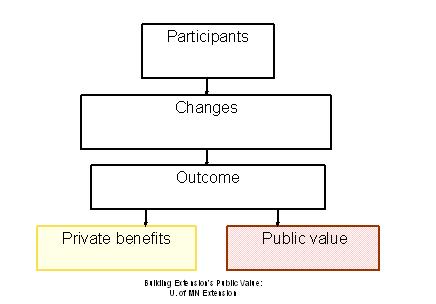You might think that after years of teaching BEPV workshops that I would have heard any and all possible questions and comments about public value, but that is not at all the case. Great input at every stop keeps me thinking, learning, and revising the way I talk about Extension’s public value.
Earlier this week I taught a pair of BEPV workshops for University of Missouri (MU) Extension in Columbia, MO. One MU faculty member drew attention to the public value message diagram, which asks for a specific behavior change that program participants adopt. The participant observed that sometimes Extension programs validate the choices that program participants are already making. Rather than inducing a change in behavior, the program serves to solidify an existing beneficial behavior. Imagine a participant in a nutrition education program who has been trying to eat a heart-healthy diet based on information he has gathered on his own. In the program he learns that he is in the right track. That validation steels his resolve, and he continues his beneficial food choices. The public value message for this program might say that program participants either adopt or maintain healthful food choices (or something more specific, such as eat primarily whole grain carbohydrates).
I can think of a time when this happened to me. A couple of years ago I read a University of Minnesota Extension resource with communication tips for parents of teenagers. A few of the tips were new to me, but many were things that I already was trying to do, albeit instinctively, rather than consciously. Reading the tips made me consciously aware of the way I talk to my own kids, and gave me a reason to persist with what I already was doing right (and change a couple of things I was doing not so well!).
One caution about using a public value message that talks about maintaining a beneficial behavior: skeptical stakeholders want us to direct our program resources toward achieving the greatest possible benefit. Targeting participants who already have made positive choices may not seem like the best investment. Perhaps we could have a greater impact by focusing resources on those whose behavior is the farthest from ideal. To address this challenge, you may need to persuade your stakeholder that potential participants who are already doing well are in danger of reverting to poor choices if they do not receive the validation that comes from being exposed to research-based Extension education. Why might they revert? The positive choices might be costly to them (in terms of money, time, or comfort), or they may be influenced by advertising messages encouraging them to choose a different path.
What do you think? Is maintaining a beneficial behavior a valid objective of an Extension program, or should we always look for ways to make the greatest marginal change?
